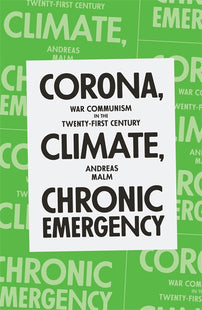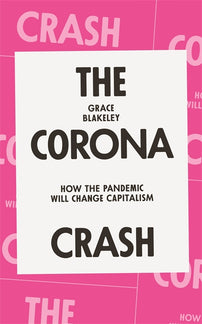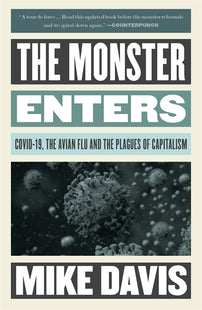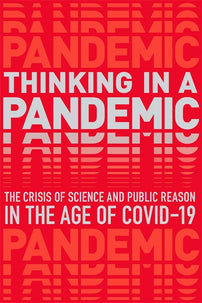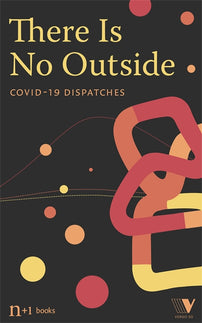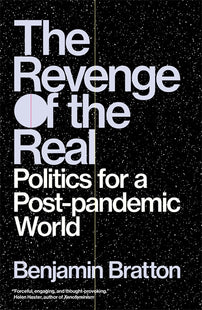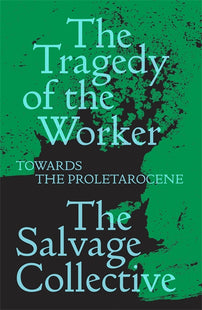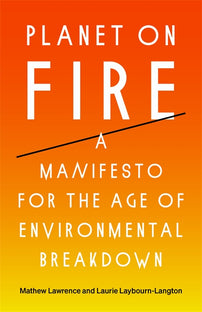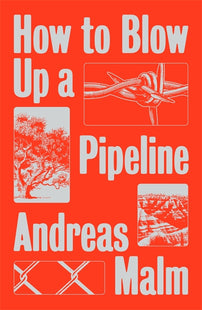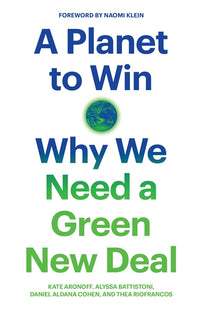Back to the present. Global Spaces, Pandemic crises and Ecological Counter-Powers.
How can we develop a theory and practice of ecological counterpower that is commensurate to the coming catastrophe? Davide Gallo Lassere on the limits of Andreas Malm's ecological Leninism.

Let's say it right away: though Andreas Malm's diagnosis of the pandemic is striking; thought provoking, the ecological Leninism that he puts forward in his enthusiastic pamphlet on Covid-19 appears quite debatable. Moreover, it seems questionable in the light of the epistemological presuppositions and historical analyses elaborated by Malm himself in his previous work centred on the political centrality of social struggles (Malm, 2016). Furthermore, it feels out of step with the examination of global space that gives substance to his essay. In this respect, workerist readings of the classics of revolutionary thought and contemporary geographies of capital seem to me to distil a good vaccine against the fever of 'a desire for the State' (Toscano, 2020) that springs from certain passages of Malm's Corona, Climate, Chronic Emergency (especially the third part).
Let us proceed in order. The path laid out by critiques of the Capitalocene have led us to China - a hotbed of several global trends. And it is also from this part of the world that we must start if we are to understand the processes that are fundamentally changing the most recent present. The temporal logic behind climate change shows us that the warmer the planet becomes, the more that complex and multiscalar dynamics retroact on ecosystems, in turn warming it further. Hence the vital need to intervene as soon as possible to reverse the status quo before the situation gets permanently out of hand socially and politically - that is, before the dark side of nature's autonomy takes over. Although on a minor scale, a similar urgency emanates from the social forces that drove the outbreak and spread of Covid-19. While this virus has not had the power to erode the very foundations of human life on Earth (and of many other species for that matter), the deadly disruption that SARS-CoV-2 has been able to generate in our time calls for a comparable degree of promptness and radicalness in response. Before discussing the political perspectives that emerge from this recent book, let us focus on the sequence of the pandemic's onset, surveying the socio-economic processes and the spatio-temporal coordinates of its unfolding.
[book-strip index="1" style="buy"]Horror vacui, deforestation and zoonoses
The logic of capital accumulation imposes the relentless conquest and replenishment of geographical space. To leave a place vacant means to not exploit it. The incessant widening of the circuit of capital reproduction determines an expansive tendency to saturate the world; to continue invading, to colonise it even further, and to arrange it increasingly according to the needs of maintaining the dynamic of development. To spread and deepen the presence of devices that stimulate accumulation processes is the endless end of the perpetual drive for unlimited growth. In this respect, virgin forests are a terrain to be cleared; they are an invitation to be appropriated and subjected to the harsh laws of the market. From the point of view of capital cartography, the vacuum they give rise to in terms of profit must be filled. But what are the systemic constraints that push to advance the boundaries of capital to such places and thus erase these unbearable white gaps from the maps? At the beginning of the millennium, the loss of tropical forests has been fundamentally determined by commodity production. Specifically, four goods account for the lion's share: in descending order, beef, soya, palm oil and timber. These products alone are responsible for 'four tenths of the dramatically sped-up tropical deforestation between 2000 and 2011, split among seven countries in Southeast Asia and Latin America' (Malm, 2020: 45). Far from leading to a domestication of the wilderness, however, the compulsive appropriation of remote territories and the brutal extraction of difficult-to inaccessible resources have released pathogenic micro-organisms, which were quickly absorbed into the circuits of global capital to the point of necessitating the shutting down of entire sectors of the economy and the restricted movement of three billion people worldwide for several weeks. Thus, the sorcerer's apprentice of capitalist accumulation, once confronted with the demons of deep nature, unleashed a monster that is difficult to tame.
Rebus sic stantibus, we must expect the emergence of other pandemics in the years to come. Indeed, over the past two decades we have already witnessed the eruption of several viral diseases on the global scene. Although their epidemic peaks have never reached the heights of Covid-19, avian flu in many countries of the world, SARS in South-East Asia in particular, MERS in the Middle East or Ebola in sub-Saharan Africa are among the most fatal. Despite the different morbidity rates, lethality levels, absolute numbers and composition of deaths, so-called spillover is at the root of these infections. What is this and why do climate change and deforestation processes play such a decisive role in such a phenomenon? Spillover refers to the transfer of a pathogen from one animal to another of a different species. The new animal may be hostile to the reproduction of the virus or may, for many reasons, be a more favourable host, an 'amplifier host' - allowing the spread of the virus to be revived on a larger scale. As has been said, all too often 'big farms make big flu' (Wallace, 2016).[1] Indeed, biologist Robert Wallace has shown that factory farms of animals destined for slaughter are dangerous breeding grounds for contamination. Intensive farming practices - such as pig feedlots, poultry farms, etc. where animals undergo dubious genetic selection processes - provide a favourable environment for the evolution of pathogens that are particularly aggressive because of the high density of host organisms, their low immune resources and the shortness of their life cycles. When the spillover occurs between an animal and a human being - with the possibility of intermediate animals carrying the virus from one to the other, making it evolve in the 'right' direction - it is called zoonosis... 'a word of the future', wrote Quammen in 2012 'destined to become much more common in the course of this century' (Quammen, 2012: 21).[2] With SARS-CoV-2 the mediating place was not a factory farm, as with bird flu at the end of the 20th century or probably also as with Spanish flu in 1918, but likely a wet market - so called because of the frequent rinsing that takes place after the slaughter of meat -, where dozens of different species rub shoulders with each other.
In any case, it is the penetration of capitalist business into little-explored corners of the rainforests that brings us into contact, directly or indirectly, with wild animals carrying viruses against which our immune systems are deficient. In this respect, Latin America, Central Africa and South-East Asia are the regions most at risk. The expansion of export monocultures in these parts of the world (palm oil, soya, coffee, cocoa, tobacco, sugar cane, fruit products, etc.), together with the grazing of wooded areas, represents the most advanced front for the devastation of previously (almost) intact natural environments. Deforestation thus increases the risk of encounter, contagion and transmission between viruses that affect animal species and human beings. But that is not all. Deforestation is responsible for two other things. Firstly, uncontrolled deforestation leads to the loss of biodiversity, which not only triggers numerous spillover effects that destabilise ecosystems, but is also closely linked to spillover itself. The variety of species actually increases the likelihood of viruses finding a bad host, producing a diluting effect that compromises the 'spillover' effort: the richer the biodiversity, the lower the possibility of zoonotic diseases. Secondly, deforestation fragments forest areas, which accelerates the evolution of pathogens for two reasons: firstly, because host animals are confined to smaller habitats, where contacts are closer; and secondly, because these chronically stressed conditions force them to make long migrations, thus facilitating the spread of the virus. In short, 'the hotspots of spillover are the hotspots of deforestation: and they are located in the tropics' (Malm, 2020: 43).
And yet, among the candidates for the best virus smuggler prize, the bat is undoubtedly the favourite. Or better still: it is the champion of zoonosis. With its 1,200 species worldwide, the bat has some 65 million years of speciation behind it, which has enabled it to modify its genome and develop a very powerful immune system. Thus, together with rodents, they have become healthy carriers of a huge number of viruses. The fact that it is a mammal also facilitates transmission - very often via an amplifier host - to humans. In addition to its ancestral history, the bat's formidable capacity for adaptation and resistance to viruses derives from at least two other specific characteristics: the bat is the only mammal that can fly and it is a gregarious animal. The downside of the first factor is a body temperature of 40°, as the bat is forced to flap its wings frantically to take flight and soar through the air. Such a gradation does not seem to disturb the mammal, while it makes the viruses more robust to the self-defence mechanism of fever. Secondly, bats live in colonies that can number in the thousands, with roosts hidden in ravines or caves. Such a concentration in such closed places is an excellent formula for herd immunity. All these reasons make the bat a prodigious reservoir host (Malm, 2020: 36-50). And indeed, bats harbour more than 3,000 different types of coronavirus. Of course, not all of these viruses have the capacity to jump from one species to another, land on humans and proliferate among us. However, it is clear that phenomena so disruptive to natural environments, such as deforestation and global warming, will force them to migrate further in search of more comfortable habitats. And it is also clear that flight allows swarms of these animals to cover long distances and thus increase the possibilities of intercepting a larger number of potential hosts. 'Bats, in other words, live by breaking the two principal rules of the 2020 lockdowns: do not travel and do not form crowds' (Malm, 2020: 37). Therefore, protecting wildlife areas from climate change and deforestation means intervening in the very causes of future pandemics and thus safeguarding the habitability of the planet - which implies a drastic and immediate diversion of the tracks on which globalisation has been running until now.
And so goes globalisation
The systemic tendencies of capitalist accumulation have given rise to the Covid-19 disaster as a counter-purpose: Stuff wild animals on top of one another and all pandemic hell will sooner or later break loose, as a predictable by-product of how the wild is handled' (Malm, 2020: 66). While certain sectors of big capital, such as the GAFAMs or the security giants, are amassing formidable amounts of money, we find ourselves in the midst of one of the most devastating economic crises in the whole history of capitalism. But how is the complex web of financial, productive and commercial relationships that stalks animals and flushes out viruses structured on a global scale, tying together the different regions of the planet? What can we learn from the global chronology of the victims of Covid-19 and the socially differentiated impact of the health and economic crises? What political lessons can we draw from all these processes?
To understand the eco-pandemic significance of rampant globalisation, Malm coined the term 'ecologically unequal and pathological exchange' (Malm, 2020: 50-55). This original formulation identifies the indissoluble link that persists between the quantities of biophysical resources embodied in goods destined for Western markets and the production of conditions conducive to the development of viral diseases in the global South. The apparent fairness of the monetary transactions that regulate international trade is in fact based on a radical asymmetry, with the consumption of countries in the global North absorbing the bio-diversity and land of other continents. Behind the universal equivalent of money lies in fact - among others - the specific inequality of the drainage of raw materials. In this sense, Europe, North America and Japan are the epicentres of the global flows of goods that characterise the ecologically unequal and pathological exchange. To supply their needs, not only for food, these regions depend like all others on imports. However, if counted in land or biodiversity loss and not in dollars, the overall balance of foreign payments appears heavily unbalanced in favour of the countries of the South.
This is another, no less compelling way to calculate the ecological debt of the global North. In the case of the EU, for example, beyond the deep divergences between the countries of the centre and the periphery, its total trade exports show a more or less large monetary surplus with several countries of the global South; while it is estimated that in 2007 the 'the EU had a net import of goods embodying land as large as the entire surface area of India' (Malm, 2020: 51).[3] It is on the basis of such ecological disproportionality that the objective conditions for the rise of viral infections are created. Unequal ecological exchange is therefore not only one of the primary sources of keeping the countries and people of the Global South in a state of economic dependence and poverty vis-à-vis the North, but it is also an important driver of deforestation, which 'is an engine not only of biodiversity loss, but of zoonotic spillover itself' (Malm, 2020: 42).[4]
However, this ever-present legacy of the colonial era is turning into an insidious Trojan horse. In a period haunted by the chronic fate of epidemics, being a nerve centre in the global flow of goods is a double-edged sword. In the case of SARS-CoV-2, the hotspots for the spread of the virus - at least in the early stages - were several crucial nodes in the global circulation of capital: Lombardy, the Ile-de-France, the metropolitan areas of London, Madrid and Brussels, New York and its hinterland. This defines the closing of the loop, or the almost perfect coincidence between the circulation of money and goods, the circulation of human beings and the circulation of viruses. The global transport network thus proved to be not only a catalyst for the pandemic, but its real conditio sine qua non. Yet the existence of this phenomenon is not new in itself. Already in previous pandemic episodes, diseases moved from one centre of global merchant capital to another before reaching the countryside. It is the speed of the process that is new. In the past, viruses and parasites travelled by sailing ships and caravans, trains and steamships. Only with the advent of aeroplanes, and the democratisation of their use, have pathogens had access to such vast territories and populations in such a short time. The space-time compression made possible by the development of productive forces, to resurrect an old concept that is still relevant today, has triggered a paradoxical domino effect. Indeed, while every region of the world and all strata of society were affected by Covid-19, it was first the richer areas and classes that bore the brunt, and then the poor. Despite this, as the health and economic crises deepened, it was the lower classes that paid the highest price. And once again, those who did the least to bring about the disaster are bearing the brunt of its consequences.
In order to theorise the diagnosis of on-going climate and pandemic disasters we must therefore recognise the social and historical character not only of the conditions that favour exposure to tragic events, but also of the dynamics that determine their emergence. With the current phase of globalisation, the capitalist imprint permeates even the very processes of causing shocks, instead of intervening only post festum. Traditionally, the critique of natural disasters attributes social relations the function of amplifying the damage. From the Rousseauist reading of the Lisbon earthquake to the critical theories of vulnerability, the emphasis is precisely on the social rather than the natural: if society were not so unequal, then the toll of such and such a disaster would have been less dramatic. On the contrary, critical epidemiology or Marxist biology show that not only the consequences, but also the root causes and dynamic pressures behind natural disasters are increasingly social. Fossil fuel burning, CO2 emissions, etc. in the case of global warming; deforestation, mass exterminations of animals, etc. in the case of epidemics/pandemics: these are what cause more droughts, fires, heat waves, floods, storms or hurricanes on the one hand, and more zoonoses on the other. Therefore, the critique of neoliberal violence - including security and health governance - can no longer be separated from the radical questioning of the deep-rooted tendencies towards domination and commodification of nature (Malm, 2020: 100-07).
[book-strip index="2" style="display"]Capitalocene and chronic emergency
Climate change and the Covid-19 pandemic are two heterogeneous expressions of the ongoing ecological crisis. Unlike the social, economic and political crises that recursively haunt capitalist societies, the ecological crisis does not follow a cyclical but an exponential trend. The unbridled subsumption of nature is in fact producing ever more virulent backlash, which is undermining the very assumptions on which the profit motive is based. The eco-Marxist theorist James O'connor refers to this process as the second contradiction: the constraint that drives capital accumulation to destroy the material conditions that ensure its reproduction (O'connor, 1994). According to Malm, who endorses such a reading, we have entered an era of chronic emergencies, where States will be increasingly obliged to intervene on a massive scale to take care of the health of the workforce and consumers. In this respect, the pandemic is an excellent case study of the extent to which the powers may be required to induce major economic crises on both the supply and demand sides - if the survival of populations is threatened. Unfortunately, the extraordinary measures adopted to limit losses - literally unheard of in peacetime - have targeted the symptoms of the crisis, leaving the causes out of sight. To overcome the gravity of the current situation, however, we need an opposite strategy, one that is dedicated to uprooting the evils that fuel the ecological crisis and not simply to managing its deleterious consequences more or less effectively. For Malm, such an authentically revolutionary approach should revive the typical gesture of the Bolsheviks, who, in the midst of the Great War, had the capacity to transform the crisis of symptoms into a crisis of causes, i.e. had the strength to turn the imperialist war between the global powers into a revolutionary civil war.
The singularity of the 1917 revolution consisted in a conscious intervention to stop civilisation as it had been manifested until then, by putting an end to imperialism and class exploitation. This is the ever-reactivating philosophical-political and historical-universal legacy of the Soviet October. Beyond its concrete achievements and its Stalinist degeneration, the seizure of the Winter Palace set in motion a process of immanent transcendence of modernity; it inaugurated a dynamic of self-surpassing made of ruptures and extensions of its heritage. The 'ecological Leninism' that Malm calls for must therefore be understood as drawing on an archive from which to locate sources of inspiration, and not as 'a party affiliation' (Malm, 2020: 153). This implies, in the first place, a keen sense of the conjuncture. In the age of the actually existing Capitalocene, the author says, quoting the English collective Salvage, 'all politics must become a disaster politics' (Malm, 2020: 164).[5] Although its negative consequences are affecting different regions of the world and different strata of society in both an uneven and combined way, the current crisis is already eminently tragic and is destined to become more so. It is this sense of urgency that prompts Malm to declare two obituaries (Malm, 2020: 119-25) - one for social democracy, the other for anarchism - thus directing his political perspective towards 'ecological war communism', rather than a 'mere' Green New Deal.
For the Swedish researcher and activist, the 2010s have sounded the death knell for any reformist variable and any pretence of disregarding the State lever, pushing the doors wide open to the most intransigent realism that makes State power an indispensable tool. The gradualism and long-termism of the social democracies are in fact part of a period that is now over: we are already in the middle of a temporality that makes the hope in the slow improvement of living standards on the basis of social dialogue and compromise between opposing parties naïve and obsolete. The failures of Latin American progressive governments, the experiences of Syriza and Podemos and the defeat of the electoral campaigns of the Anglo-American left are proof of this. This does not mean that these formations no longer have a role to play; on the contrary, they simply have to go beyond themselves if they are to survive the hardening of the confrontation that has been underway since 2008. Equally condemned are the far-left horizontalism and radical anti-statism, relegated to the dustbin of history not only by the post-crisis strengthening and radicalisation of neoliberalism, but above all by the challenges posed by Covid-19 and, even more so, by global warming. The lights and shadows assessment of the Arab springs, the square occupations, the feminist strikes, the anti-racist and environmental and climate justice movements or the multiple 2018-19 popular uprisings invite us to revisit the irreducible distance from the State machine. A certain degree of hard power seems necessary to eradicate uncontrolled deforestation, to ban the brutal extraction of natural resources or to convert the multinationals of fossil capital; just as a minimum of centralisation and verticality seem inescapable in order to provide for the needs of complex and differentiated societies, starting with those related to health. In short, the public cannot be suddenly and entirely supplanted by the common.
Now, without commenting on these positions, which would deserve an in-depth discussion, but nevertheless bearing them in mind, I will limit myself in the following pages to deconstructing Malm's theses in the perspective of a constructive confrontation. I would like to address two criticisms to him, which aim to conclude by bringing them into dialectical tension with his ecological Leninism.
War Communism and Ecological Leninism
First of all, it seems to me that his search for a royal road to political realism fails to interrogate the State-form that is supposed to implement such radical measures. Which State is in question? The nation-State as we knew it in the 19th and 20th centuries? Only a great power, or can any State do the job? Is an isolated State, going alone capable? Or is ecological war communism in one country only not a contradiction in terms? Should we consider some kind of inter-state grouping or alliance? If so, on what basis: geographical, political, or both? And to what end? A Green Comintern? A people's Green Bretton Woods? If so, what role can international, transnational or supra-national institutions play? The potential of the State arsenal and its relative autonomy from the immediate interests of big capital came to light in the early stages of the pandemic. If only the State spheres have the power to rapidly reach the macroeconomic and macro-political issues that can bring about a genuine socio-ecological transition on a global scale, then questions of global governance, sovereignty in the 21st century, so-called legitimate violence in a multipolar world, the allocation of resources in the age of platforms and NTICs, etc. cannot remain unanswered. For the sake of realism, the outline of a theory of the State seems necessary to anchor such a statement in a truly strategic perspective. This is all the more true given that the establishment of a chronic state of emergency could lead to the institution of a Leviathan, or worse, a climatic Behemoth (Wainwright, Mann, 2018).[6] The State cannot be treated as a simple, unitary and transhistorical given, unless one willy-nilly relies on a kind of 'impolitics' of social transformation. This is implicit in many of the subterranean threads that run through the third part of Corona, Climate, Chronic Emergency.
Despite Malm's close attention to and active participation in environmental movements (Malm, 2021)[7] , Corona's political realism seems to oscillate between two opposing, but specular, pitfalls. On the one hand, it seems to bet teleologically on a breaking point determined by the climate crisis. Just as the cloud carries the storm, global warming carries the necessary striking force to bring about a radical change in the course of history. Where we would expect a sketching out of a theory of the subject, Malm delegates all the dirty work to the autonomy of nature and not to the autonomy of subjectivities that oppose business-as-usual. At its peak, the objective advancement of climate change will eventually ensure that the threshold that threatens the reproduction of the human race is exceeded - more or less synchronously in the four corners of the planet, as with the pandemic -, forcing the State to intervene. The inexorable escalation of negative externalities produced by the fierce domination of nature constitutes the ultimate contradiction of this singular ecological variable of the theory of collapse, which does not mechanically open up (as the author knows very well) to a rosy future.[8]
On the other hand, Malm seems to be sliding towards voluntarism. At no point does he say who will manoeuvre the levers of State command to bring us to the right side of history. Where we would expect a primer of a theory of organisation, we find ourselves in the hands of an indeterminate autonomy of the political: like a deux ex machina, a vanguard nurtured by the lessons of the Bolsheviks will one day appear, to lead the final assault at the very heart of the State. Despite its evocative feature, the reference to the Russian Revolution remains limited here to the experience of war communism, i.e. after the Communist Party has seized power. Not only are we far away from such a situation, but the October 17 insurrection was not a bolt from the blue; it was prepared by the 1905 defeat and by the advance of the February 1917 uprising, i.e. by the rise of mass self-organisation movements in the factories, in the army, in the neighbourhoods, etc. What is surprising in Malm's presentation, then, is not his anti-idealist insistence that 'there can be no clean break' (Malm, 2020: 165); but the conspicuous absence of a political theory of social transformation, the seeds of which have nonetheless peppered his historiographical studies on fossil capital and the Capitalocene (Malm, 2016). Paradoxically, the ultra-political approach of this brilliant pamphlet on Covid-19 lacks three incontrovertible pillars for any politics: a theory of the state, a theory of the subject, a theory of organisation.
But what political hypothesis around these three points could we put forward from a historical diagnosis similar to Malm's? Perhaps zoonosis or climate change will eventually bury capitalism (and humanity with it), yet Lenin's most valuable teaching is not to entrust 'all power to crises' or to transpose the contents of his politics timelessly into another context. As Malm himself suggests with his valorisation of the Leninist gesture, what is still alive from Lenin is rather his method. "Lenin as method", according to the workerist reading, means always adapting the political line to a concrete analysis of a concrete conjuncture and to a careful study of the social and political composition of the subaltern classes. Lenin then becomes the name of the organisational form capable of enabling the subjects to interrupt the continuity of capitalist exploitation and domination in a specific situation. In this sense, we cannot refer to Lenin without constantly updating him, that is, without constantly leading Lenin beyond Lenin.[9] In this respect, it seems to us that an approach based on the demultiplication and strengthening of counterpowers makes it possible to elaborate the political perspective of ecological Leninism in a way that is more coherent with the historical phase we are going through, i.e. with the State-form that has emerged since the 1970s crisis and with the social and political composition embodied by the post-2008 cycles of mobilisation.
Counter-Powers and Transition
If one adopts a global and long-term perspective, which is in fact the only one capable of accounting for the development of capital, it becomes clear that the spatio-temporal composition of the accumulation processes is fundamentally heterogeneous. From the very beginning, the capitalist multiverse has produced a highly differentiated social geography and historicity. Moreover, the new phase of globalisation that emerged with the end of Fordist Keynesism, far from standardising spaces, triggered centrifugal and centripetal effects that produced further hierarchies between different regions of the globe. This upheaval of the contemporary world at different speeds and geometries has had an impact on the capitalist State, restructuring it in depth. Since the 1970s, the deployment of capital has largely dispossessed the nation-State of its power to regulate the economy. The pressures exerted by financial markets, the rise of gigantic multinationals, the transnationalisation of the circulation of goods, the growing power of organisations such as the WTO or the IMF, etc. have fractured the unity of the State: its territory, its institutional apparatus and its modalities of operation. The State has thus been increasingly stripped of its sovereign prerogatives. The case of the EU member States is emblematic in this respect: the redefinition of their constitutions (Brussels) and the transfer of monetary issuance (Frankfurt) go hand in hand with the limited nature of their autonomy in matters of security (NATO) and foreign policy (Washington). Even more striking is that of the countries of the global South, which are subject not only to the diktats of trans-, inter-, or supra-national powers, but also to the blackmail of the dominant States. This does not mean, however, that we should confine ourselves to a 'negative theory' of the State, which is designed to emphasise what the State cannot or can no longer do today. Beyond the debate that raged during the 1990s and 2000s between those who highlighted the fragmentation of the State through the processes, devices and assemblages of globalisation (Sassen, Negri) and those who emphasised the persistence of its unity, its capacity to suspend the normal functioning of the law and to impose a state of exception (Agamben), what is becoming increasingly important is to mourn the loss of the State as a priority terrain for liberation policies, without deserting the battlefield.
It is against the backdrop of this historical-geographical and socio-economic framework that a theory and practice of dual power, at the intersection of autonomous and institutional politics, can find its way: within and against, outside and against, and outside and as an alternative to the State apparatus. Such an approach aims to articulate horizontality and verticality, anchoring in the social/territorial and institutional spheres, with a view to rooting, disseminating and reproducing foci of counter-power in the vital centres of the system. This perspective implodes the rigid oppositions between tactics and strategy or between reform and revolution that have long characterised the workers' movement, in order to think of the transition as a permanent framework of self-government of society that branches out through a thick network of counter-powers. Though in embryonic form, it is this legacy that delivers the partial successes and defeats of the 2010s cycles of struggle. These uprisings had the capacity to circulate slogans, set practices in motion and accumulate subjective, organisational and discursive experiences that shook governments in all corners of the world, yet did not interrupt the deepening trends of the crisis. We also saw the emergence of similar experiences in the wake of the start of the pandemic in December 2019 with significant workers' struggles and anti-racist insurgencies, accompanied by highly contradictory State and institutional policies - especially in the very early stages of the pandemic, i.e. before the recalibration of the capitalist governance of the crisis.
Pandemics, in fact, 'need not to be thought, by analogy with war, as biological arguments for the centralisation of power'. What should be done instead is to learn to think and act 'like epidemiologists' (Toscano, 2020: 9). In this respect, an approach in terms of dual biopower, to use the beautiful expression coined by Alberto Toscano (2020) and Panagiotis Sotiris (2020), provides a welcome alternative to the 'desire for the State' that has emerged from some parts of the global radical left. In their interventions, Toscano and Sotiris have clearly shown the political potential of a perspective anchored in the sphere of reproduction (health, education, housing etc.), which contains in itself the germinal traces of a counter-strategy antagonistic to State sovereignty and neoliberal governance, by being entirely centred around social struggles and democratic knowledge.[10] From the experiments of the Black Panthers to the invention of new institutions and forms of self-government in Chiapas and Rojava, via the counter-knowledge practices of Act Up, land conservation projects by indigenous communities, etc., these prefigurative projects show important strengths, but they also make explicit the limits to be overcome. On the one hand, they can constitute 'the fulcrum from which to think the dismantling of capitalist social forms and relations without relying on the premise of a political break in the operations of power, without waiting for the revolutionary day after'. On the other hand, they pose the problem of 'how they can be scaled up and coordinated - while not giving up the State itself as an arena of struggles and demands, especially over the meaning and the materiality of 'welfare' and of the social wage broadly' (Toscano, 2020: 10). Indeed, these policies - which are configured as a communist governmentality, i.e. a strategy giving substance to 'a 'democratic biopolitics' or 'biopolitics from below'' (Sotiris, 2020: 4, 19) - must also always be included in a framework of struggles 'that acknowledges the centrality of class antagonism' (Sotiris, 2020: 19).
The series of questions we need to ask ourselves is therefore: to what extent would such an orientation be transposable to the struggle against climate change, and more generally against the ecological crisis? Secondly, how can we develop a theory and practice of ecological counterpower that is commensurate to the coming catastrophe? Who would 'ecological soviets' be? Where would their privileged locations be (workplaces, the countryside, the metropolis?) and how could they be federated? But above all, how can we ensure that their scope is embodied in a new praxis that can anticipate the future while putting the centres of current power on the ropes? The question of dual power in the time of the Capitalocene is thus part of a tragic panorama in which the politics of anti-power as well as the politics of taking power must be reconsidered in the light of chronic urgency - the only unsurpassable horizon of our time. A similar reading emerges in another recent book by Andreas Malm (2021), How to Blow Up a Pipeline, in which the author seems to be working in the direction of a pluralisation of practices, interweaving on the one hand ecological struggles, social struggles and decolonial struggles in the global North and in the global South, and on the other hand different forms of direct action: demonstrations, camps, occupations, blockades, riots, strikes, sabotage, etc. It seems to me that it is only from such an approach that the question of power can - and must! - be asked afresh today.
[book-strip index="3" style="display"]Final considerations
The power of nature has struck back. The violent disruption of its autonomy produced a pandemic that triggered an extremely violent health, social, economic and political crisis. Faced with this tragic situation, the states displayed their 'going to war' attitude: warmongering rhetoric, martial measures, full use of sovereign prerogatives, etc. The military allure of sovereignty appeared to many as a bitter but necessary pill to counter the state of emergency into which we were plunged. Present and future disasters, coupled with the hardening of ongoing geopolitical conflicts, will further mobilise these elements of language and the symbolic universe associated with war. In this respect, and without ever avoiding the pragmatic question of political violence in relation to that of (counter-)power, our task for the years to come will consist above all in reviving two other practices that profoundly characterised the revolutionary movements of the 19th and 20th centuries, i.e. those of internationalism and of the refusal of war.
Bibliography
- A. Malm, 2016, Fossil Capital, Verso;
- Id., 2017, Violent Past, Hot Present, Extreme Future, https://www.youtube.com/watch? v=AcYMnVHzVWc;
Id., 2020, Corona, Climate, Chronic Emergcency, Verso;
- Id., 2021, How to Blow Up a Pipeline?, Verso;
- S. Mezzadra, B. Neilson, 2019, The Politics of Operations, Duke University Press;
- A. Negri, 2015, Factory of Strategy, Columbia University Press;
- J. O'Connor, 1994, http://www.columbia.edu/~lnp3/second_contradiction.htm;
- D. Quammen, 2012, Spillover, Adelphi (italian edition);- Salvage (2021), The Tragedy of the Worker, Verso;
- P. Sotiris, 2020, https://brill.com/view/journals/hima/28/3/article-p3_1.xml;
- A. Toscano, 2016, After October, Before February: Figures of Dual Power, in F. Jameson, An
American Utopia, Verso;
- Id., 2020, https://brill.com/view/journals/hima/28/4/article-p3_1.xml?language=en;
- M. Tronti, 2019, Workers and Capital, Verso;
- J. Wainwright, G. Mann, 2018, Climate Leviathan, Verso;
- R. Wallace, 2016, Big Farms make Big Flu, Monthly Press;
- Id., 2020, Dead Epidemiologists, Montlhy Press;
- Zetkin Collective, 2021, White Skin, Black Fuel, Verso.
[1] More specifically on covid-19, by the same author see the book (2020).
[2] The probability of pandemic events in the early 20th century was so high that epidemiologists and virologists spoke of NBO, the Next Big One. Quammen (2012: 45, 48) added at the time that 'the difference between HIV-1 and NBO could be, for example, speed of action: NBO could be fast to kill as much as the other is relatively slow. Most of the new viruses work at high speed'. And shortly afterwards he prosaically advised: 'Let's keep the wild animals under control, because while we are besieging, encircling, exterminating and slaughtering them, they are passing the diseases on to us'.
[3] This refers to the area needed to extract, cultivate, assemble, etc. the constituent parts that make up the final products. With regard to differences in power, we must note the class component: 'to be very rich means to have all the money in the world to eat tropical land' (Malm, 2020: 54).
[4] As Malm (2020: 54-55) says of malaria, it is 'deforestation [that] is a boost for the mosquito vectors. More sunlight reaches the soil where the larvae develop; when biodiversity retreats, fewer animals prey on them. Nigeria suffers most from malaria due to deforestation. It is largely caused by the export of timber and cocoa. Such commodities end up in the north: the consumers with the greatest malaria footprint are the cocoa-guzzling Dutch and Belgians, Swiss and Germans. In this unequal value chain, ecosystem degradation and malaria risk are borne by low-income producers – or, in plainer terms: the Europeans get the chocolate and the profits, the Africans the mosquitos'.
[5] See also Salvage (2021).
[6] This is an excellent work of political philosophy that questions the transformations of global governance through the prism of the climate emergency.
[7] This is an accessible and very useful essay that critiques the fetishisation of non-violence from a perspective immanent to ecological movements.
[8] See Zetkin Collective (of which Malm is a member), White Skin, Black Fuel, Verso, 2021. See also the excellent oral intervention held by Malm (2017) at SOAS just after Trump's election, Violent Past, Hot Present, Extreme Future, https://www.youtube.com/watch?v=AcYMnVHzVWc.
[9] For the workerist reading of Lenin, see Tronti (2019), especially the chapter 'Lenin in England', as well as A. Negri (2015).
[10] On dual power theory, see Toscano (2016: 211-41), After October, Before February: Figures of Dual Power, in F. Jameson, An American Utopia, Verso, for a thought provoking mapping of the concept. See S. Mezzadra, B.
